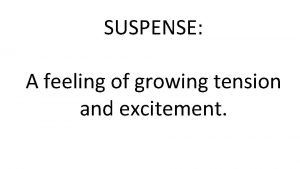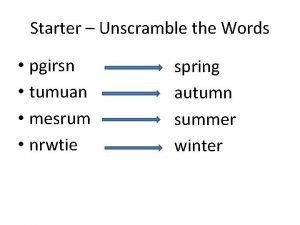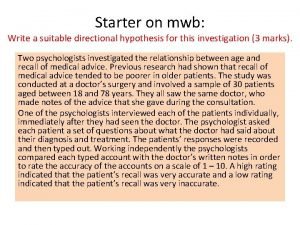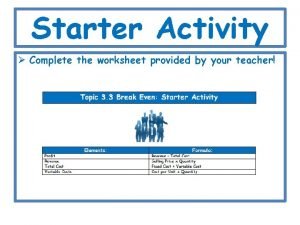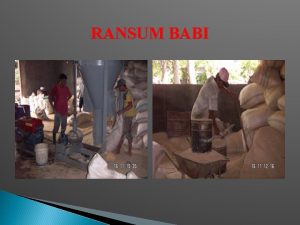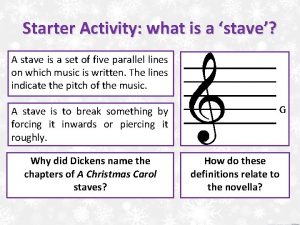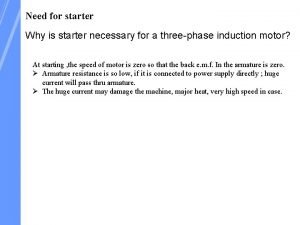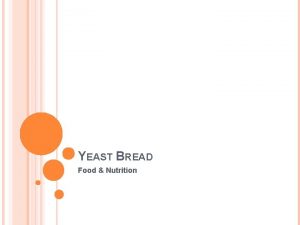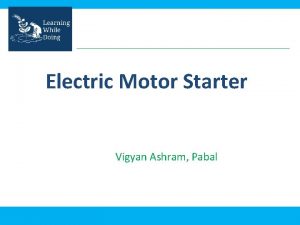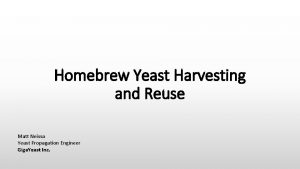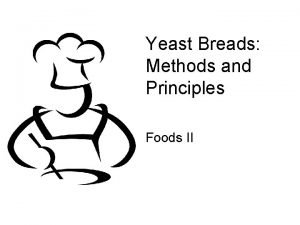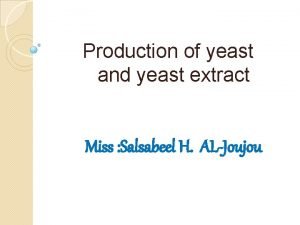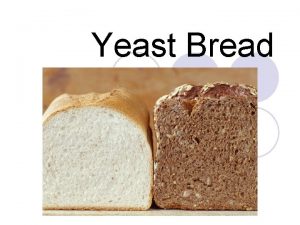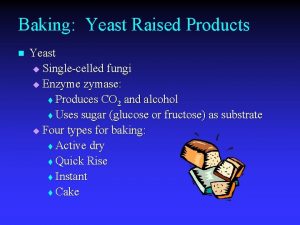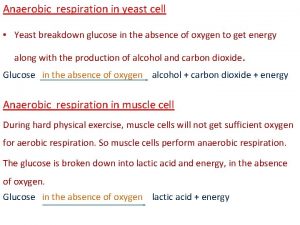Yeast Starter growing and using yeast Chris Taylor









































- Slides: 41

Yeast Starter growing and using yeast Chris Taylor Melbourne Brewers Mar 2009 1

Yeast Starters 2 Why? What? Process Dry yeast

Why? 3

Why? Healthy yeast = happy beer : ) If you get the first step wrong you are setting yourselves up for failure before you even start. Benefits – – – 4 most probably save money you will have fresh viable yeast you will learn about yeast behaviour before pitching it

Why? Increasing yeast cell count for: – – Higher gravity beers Larger batches Under pitching consequences – – – Long time for fermentation to start (lag time) Greater risk of infection Formation of more yeast defects (esters etc) 5 risk of incomplete fermentation In short you may get away with it for some of the more robust yeast strains, but results are much less predictable.

Why? 6 Ensuring yeast is healthy before pitching – Old yeast with low viability – 'Cheap' out of date liquid yeast packets – Saved yeast slurries left for too long (> 3 weeks)

Why not? More time More complex Greater risk of infection – Alternatives – – 7 But is usually detectable Buy more yeast Re using yeast

What? 8

What 9 Growing yeast, not making beer! Need to provide ideal growth conditions – Not the same as for ideal beer production – Same for lager and ale yeasts – Wort ~ 1. 020 to 1. 040 – Temp ~ 26 C – Constant agitation Driving off CO 2 helps yeast production – Nutrients (especially oxygen)

Yeast phases 10 Lag Phase – Wort acclimatization – Oxygen is extremely important. used by yeast for synthesis of sterols and fatty acids necessary for growth factors. Without oxygen growth will be very limited. Log Phase – The log phase is a time of exponential growth of the yeast culture. – The preparation the yeast made during the lag phase allows rapid multiplication of cells and consumption of sugar. – Many of the significant aromatic and flavor compounds are byproducts of cell growth and are produced during the log phase.

Yeast phases 11 Stationary Phase – Where the yeast population reaches maximum density and the remaining sugars are consumed. When the yeast have consumed all of the sugar, flocculation begins.

Process 12

Equipment Vessel to grow yeast in – Must be sanitised of course! – – – No need for airlock – – 13 Plastic container (eg Juice bottle) Jar Emerlyser flask Can sanitise with heat (heat on stove) Easy to use with a stirplate – – Makes yeast work harder. Reduced oxygen has big impact on yeast growth. Foil over the top is fine while CO 2 is being produced. Not suitable after CO 2 production has ceased.

Equipment Stirplate – – Really need emerlyser flask Can greatly accelerate yeast growth – You need one if you use start from small amounts of yeast 14 Drives off CO 2 Keeps yeast in suspension Allows more air/yeast contact, potentially allowing more oxygen access. Slants or plates, culturing from bottle dregs, etc

Ingredients – Starter Wort Dry malt extract – – Liquid malt extract – Can get at HBS and sometimes low quality types at supermarket Saved wort – – 15 1 gm per 10 ml for ~ 1. 030 SG Should be boiled up to ensure it is sanitised Must be sterile to store at room temp Can be frozen, but needs to sanitised after defrosting

Ingredients – Starter Wort Sugar? – – No hops (or as low as possible) – 16 Not recommend, does not contain any FAN or other required nutrients May be used with nutrients but still better to go with malt. Reduces yeast growth

Ingredients - Yeast 17 Packaged liquid yeast Yeast from a commercial bottle – Not really necessary these days with Wyeast and Whitelabs range, exception being Coopers. Slant or some other stored yeast Dry yeast? – Generally not worth it, and yeast is designed to be pitched as is (does not even require much aeration) Only real difference is the amount of yeast you start with. The more yeast the better!

Ingredients - Yeast Quality of starting yeast is important – – Try to avoid “stressed” and over-used yeast. – – 18 Bad parents will result in more likelihood of demented children. There are ways to reculture suspect yeast, but that is a whole new topic. Each propagation risks more mutations Yeast used in high gravity brewing is not recommended (its well and truly passed its best)

Ingredients - Yeast – Try to get yeast closest to the “source” of known good yeast in following preference: 19 Liquid yeast packet from yeast supplier Slant or stored yeast from above Yeast collected from Krausen Yeast from secondary Yeast from primary Yeast from bottle Yeast just found lying around the shed floor : p ( this is commonly known as an infection)

Ingredients - Others Yeast nutrient – FAN (Nitrogen) – Old yeast boiled up – 20 I just use cheap bakers yeast Specialised nutrient Generally available from the malt in the starter wort Contains minerals such as Zinc and Magnesium, yeast hulls, diammonium phosphate etc Will give the best overall results Oxygen!!! – Is critical to yeast growth

Process – Estimating required yeast 21 How much yeast do I need? Pitching rates – Experience!!! << This is the most important factor – Mr Malty pitching calculator – Generally accepted as 0. 75 million cells per ml per º plato wort strength ( 1 plato ~ 1. 004 ) – Need to double for lagers. – (just use the yeast calculator if you have access to it) This is a guideline only, and is often disputed!! – You really need to be familiar with the yeast strain to know how to use it properly. – No substitute for experience

Process – Estimating required yeast 22 Ale yeast, 1. 055 OG and 23 litres 0. 75 mil x 23, 000 x 55/4 – Last part is conversion from 1. 055 into º plato 237 billon cells Lager yeast, 1. 068 OG, 23 litres 0. 75 mil x 23, 000 x 68/4 x 2 587 billon cells!! Note both are considerably more than available from a single liquid yeast packet. ( ~ 100 billion, if it is fresh )

Why you want even more yeast Fast ferment – Simple test to see how attenuative your wort actually is. Ie what is the finish point? Add small amount of wort to some of the propagated yeast Make sure it is at least 2 -3 times what is required Ferment in a warm environment Insurance against: – Incomplete fermentation – Fermentation defects remediation 23 Note it does not have to be the same strain! Can use more robust and attenuative yeasts even. This is a whole new topic. Acetaldehyde Diacetyl etc

Process – Making yeast Finally lets get on with it: Most important factor is how much yeast your are starting with – High count start > 100 billion cells << Easy Starter – Low yeast count << Harder Starter 24 Liquid yeast package Save yeast slurry Dry yeast. . . only if you really need to Slants Bottles Small amounts kept under sanitised water

Making yeast - Easy Starter Prepare wort – – – 25 1 gm of DME per 10 ml water Add nutrient Boil Do it in the emerlyser flask if you have one with some foil mostly over the top will sanitise it at the same time. Cool down to pitching temp Make sure propagating container is sanitised!

Making yeast - Easy Starer Prepare yeast – – Bring it up to room temperature No need to “smack” wyeast packs, but no harm in doing so. – 26 The nutrient in the smack packs will aid yeast growth. If using saved yeast pour off non yeast liquid

Making Yeast – Easy Starter Pitch yeast into starter wort – If not using a stirplate you need to aerate well. Oxygen is one of the greatest limiting factors of yeast growth. – – 27 Shaking up a container with a lid on it is a great way to get it aerated. Don't put an airlock on the container. . . we want the oxygen to be able to get in! Add yeast to container

Making yeast – Easy starer Grow yeast – Place in warm environment ( > 22 C < 28 C is best ) – As always there is an alternative way 28 Don't let the temp drop below 20 C if possible Try to avoid large fluctuations Grow yeast at temp you want to pitch Growth rate will probably be a lot lower (especially at lager temps), but yeast will be more readily adapted to the fermentation environment Also can pitch starter wort without fear off flavours I do not recommend this method

Making yeast – Easy starer If not stirplating agitate often (the more the better) – Not making beer! – – – 29 Drives of CO 2 and give more access for yeast to oxygen. You don't really want to see a normal fermentation taking place with huge krausen etc Does not matter if there is no krausen at all Can tell it is working by the changing colour of the starer wort. The lighter it is getting the more yeast.

Making yeast – Easy starer Approximate growth rates for 100 billion cell starter – – 1 ltr starter = ~ 172 billion cells 2 ltr starter = ~ 230 billion cells 4 ltr starter = ~ 305 billion cells 1 ltr, then step up to 4 ltr = ~ 400 billion cells 30 Step up means to additional 3 ltrs to make total of 4 ltrs Make sure wort additions are boiled then cooled down as per previous steps. Growth phase should be completed in approx 24 hrs.

Making yeast – Easy starter After growth phase is complete cool down to 4 C to ensure rapid flocculation occurs – – Pour of starter wort – – 31 Ideally better to slowly cool down if possible. May need to leave up to 24 hrs achieve this step Note you should taste some of the starter wort and make sure there are no infection issues Also gives you a good idea of the types of esters etc the yeast is capable of producing. Yeast is now ready to pitch!!

Making yeast – Harder starter Starting with very small yeast counts has the following additional challenges: – – – 32 Much higher risk of infection for first step due to very low yeast cell counts Many smaller steps required to reach final pitchable quantities Starter yield will probably be much lower

Making Yeast – Harder Starter First step – – – 33 Start with no more than 20 ml of starter. Pay particular attention to sanitation for this step. Grow at same temp as easy starter. May take up 3 days for any real noticeable activity Should wait until sample is cloudy and clear evidence of yeast growth before starting subsequent steps

Making Yeast – Harder Starter 34 Step up in quantities of no more than 10 x current starer size (x 6 is even better) Allow about 24 hrs for each subsequent step Will see more signs of fermentation as original yeast begins to ferment over time A stirplate is required if you need to do this often (eg starting from slants etc).

Making Yeast - Stirplate Magnetic stirbars are much easier to work with Faster stir will result in better growth, but does not have to vortex Dont leave it on the stirplate for excessive time – – 35 it will eventually have a negative effect on the yeast 24 hrs is usually adequate

Alternative Methods Softdrink bottle method – – – 36 Put yeast and wort in a sqeezable softdrink bottle. Periodically squeeze CO 2 out of bottle. Let air back in. Shake up again. The more you do it the faster it will grow. Reportedly this method can result in rapid yeast growth in very short timeframes

How much yeast do I have? 37 Measure it! Yeast cell count – Need microscope amongst other things. – Sounds really painful, but some brewers do it. – Really need some training to do this properly.

How much yeast do I have? 38 Approximation technique – Pour off ~ 80 ml into 100 ml measuring flask when just completed. – Put into fridge and let flocculate out. – Wait for it to really compress down (takes about 2 day) – Not volume of compressed yeast (it should look much whiter by now) – Yeast will contain appox 4. 5 billion cells per ml – Can now calculate appox amount in yeast starter.

Dry yeast 39

Dry Yeast Preparation of dry yeast – You need to hydrate in water before pitching! – – – 40 Yeast that is not hydrated can not protect itself against absorption of excessive sugars results in signifigant loss of cells, and those that survive are the worse off for the experience. Use pre-boiled water, cooled down to around 25 C About 1 cup per 8 gms of yeast Let it sit in water for about 30 min prior to pitching.

Other References 41 John Palmer – How to Brewing Network – Brew Strong podcast Mr Malty – yeast pitch calculator Wyeast website Whitelabs website http: //braukaiser. com/wiki/index. php? title=Grow ing_Yeast_from_a_Plate
 Knight orthosis
Knight orthosis Romeo and juliet starter activities
Romeo and juliet starter activities Living and growing how babies are made
Living and growing how babies are made Manifest destiny and the growing nation answer key
Manifest destiny and the growing nation answer key Building keeping and growing profitable value-laden
Building keeping and growing profitable value-laden Week 22 growing pains for the new nation
Week 22 growing pains for the new nation Growing and changing
Growing and changing Growing and internationalizing the entrepreneurial firm
Growing and internationalizing the entrepreneurial firm Moving and growing
Moving and growing A feeling of growing tension and excitement
A feeling of growing tension and excitement Growing up and moving on
Growing up and moving on Starter mover flyer ket, pet
Starter mover flyer ket, pet Pictogram starter
Pictogram starter Reichstag fire who was the fire starter
Reichstag fire who was the fire starter Tumuan
Tumuan Examples of directional hypothesis
Examples of directional hypothesis Starter background
Starter background Abiotic factors clipart
Abiotic factors clipart Starter activity
Starter activity Solving equations foundation
Solving equations foundation Rounding starter
Rounding starter Reinforcement detailing of rcc members
Reinforcement detailing of rcc members Pakan babi grower
Pakan babi grower In media res novelle
In media res novelle Structure of skeletal muscle
Structure of skeletal muscle Midlife crisis starter pack
Midlife crisis starter pack Biological ennoblement
Biological ennoblement When the starter is bent upward into simple upfold called
When the starter is bent upward into simple upfold called Starter words for wordle
Starter words for wordle Nth term starter
Nth term starter Good morning starter
Good morning starter Starter
Starter Starter s11
Starter s11 Multiply starter
Multiply starter Whats a stave
Whats a stave Paired statement key
Paired statement key Holger christiansen as
Holger christiansen as Dol starter working
Dol starter working Alternative reference rates
Alternative reference rates Bang the starter’s gun— thin raindrops
Bang the starter’s gun— thin raindrops Maths bot starter generator
Maths bot starter generator Honor show chow poultry starter
Honor show chow poultry starter









